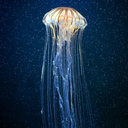The Role of Glycerol and Inorganic Ions in Osmoregulatory Responses of the Euryhaline Flagellate Chlamydomonas pulsatilla Wollenweber.
Palabras clave
Abstracto
The green euryhaline flagellate Chlamydomonas pulsatilla Wollenweber, isolated from a coastal marine environment, was grown exponentially over the salinity range of 10 to 200% artificial seawater (ASW). The cellular volume and aqueous space of the alga, measured by [(14)C] mannitol and (3)H(2)O tracer analyses of centrifuged cell pellets, ranged between 2.3 and 3.1 picoliters and between 1.5 and 2.1 picoliters, respectively. The nonaqueous space determined in those analyses (28-35%) was consistent with the cell composition of the alga. The glycerol content of the alga increased almost linearly with increasing salinity; its contribution to intracellular osmolality at 200% ASW was about 57%. The contribution of amino acids and soluble carbohydrates to the cell osmotic balance was small. Intracellular ion concentrations determined by analyzing centrifuged cell pellets of known [(14)C]mannitol space by atomic absorption spectrophotometry, and by neutron activation analyses of washed cells were similar. At 10% ASW, potassium and magnesium were the major cations, and chloride and phosphate were the major anions. The sodium and chloride content of the alga increased with increasing salinity; at 200% ASW the intracellular concentration of both sodium and chloride was about 400 millimolar. The intracellular osmolality (pi(int)) matched closely the external osmolality (pi(ext)) over the entire salinity range except at 10% ASW where pi(int) exceeded pi(ext) by 120 to 270 milliosmoles per kilogram H(2)O.


